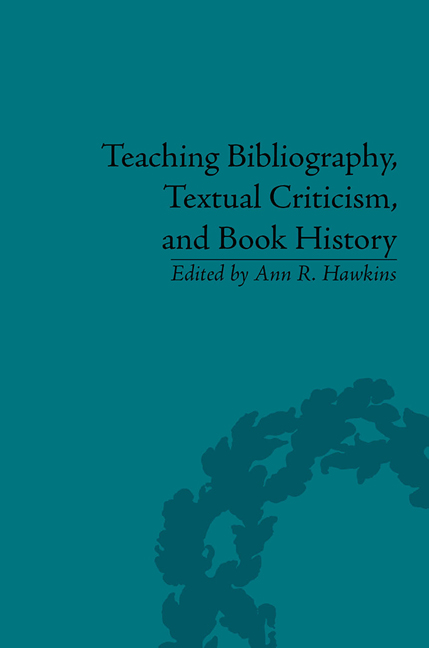Book contents
- Frontmatter
- Contents
- Notes on Contributors
- Foreword
- Introduction: Towards a pedagogy of Bibliography
- Part I Rationales
- Part II Creating and Using Resources
- Part III Methodologies
- Teaching ‘History of the Book’
- Teaching Bibliography and Research Methods
- Teaching Textual Criticism
- 20 How Things Work: Teaching the Technologies of Literature
- 21 ‘Not to Pick Bad from Bad, But By Bad Mend’: What Undergraduates Learn from Bad Editions
- 22 Book History and Reader-Response Theory: Teaching Shakespeare's Romeo and Juliet and King Lear
- 23 Textual Criticism: Students as Book Detectives and Scholarly Editors
- Afterword
- Part V Resources
- Index
22 - Book History and Reader-Response Theory: Teaching Shakespeare's Romeo and Juliet and King Lear
from Teaching Textual Criticism
- Frontmatter
- Contents
- Notes on Contributors
- Foreword
- Introduction: Towards a pedagogy of Bibliography
- Part I Rationales
- Part II Creating and Using Resources
- Part III Methodologies
- Teaching ‘History of the Book’
- Teaching Bibliography and Research Methods
- Teaching Textual Criticism
- 20 How Things Work: Teaching the Technologies of Literature
- 21 ‘Not to Pick Bad from Bad, But By Bad Mend’: What Undergraduates Learn from Bad Editions
- 22 Book History and Reader-Response Theory: Teaching Shakespeare's Romeo and Juliet and King Lear
- 23 Textual Criticism: Students as Book Detectives and Scholarly Editors
- Afterword
- Part V Resources
- Index
Summary
I have incorporated my work with seventeenth-century manuscripts, bibliographical studies and the phenomenology of reading into a year-long course covering eleven Shakespeare plays and his sonnets. The results were good; students enjoyed the activities and wrote final papers reflecting a more meaningful engagement with the texts. We brought book history and a pragmatic textual criticism to bear on two tragedies with complicated textual histories: Romeo and Juliet and King Lear.
The text of Romeo and Juliet exists in two Quartos, of 1597 and 1599, whose striking differences in content have led editors to construct, and critics to rely on, editions that amalgamate the two versions. Similarly, the 1608 Shake-speare His Historie, of King Lear differs significantly from the 1623 The Tragedie of King Lear published in the First Folio. Recent developments in book history and textual criticism have revitalized study of texts from the past. As a result, different versions of one dramatic text are no longer assigned designations ‘bad’, ‘corrupt’, or ‘inauthentic’, but are instead embraced as important and often equally valid parts of the social and theatrical history in which these texts were produced and performed. Thus, in 1997, the one-volume Norton Shakespeare, based on the Oxford edition, printed the two King Lear versions separately, and Oxford ‘World's Classics’ did the same with the two Quartos of Romeo and Juliet, edited by Jill Levenson. Students also have access to levenson's online compilation of over 170 promptbooks providing performance records of each play from the seventeenth century to about 1980.
- Type
- Chapter
- Information
- Teaching Bibliography, Textual Criticism, and Book History , pp. 167 - 173Publisher: Pickering & ChattoFirst published in: 2014



